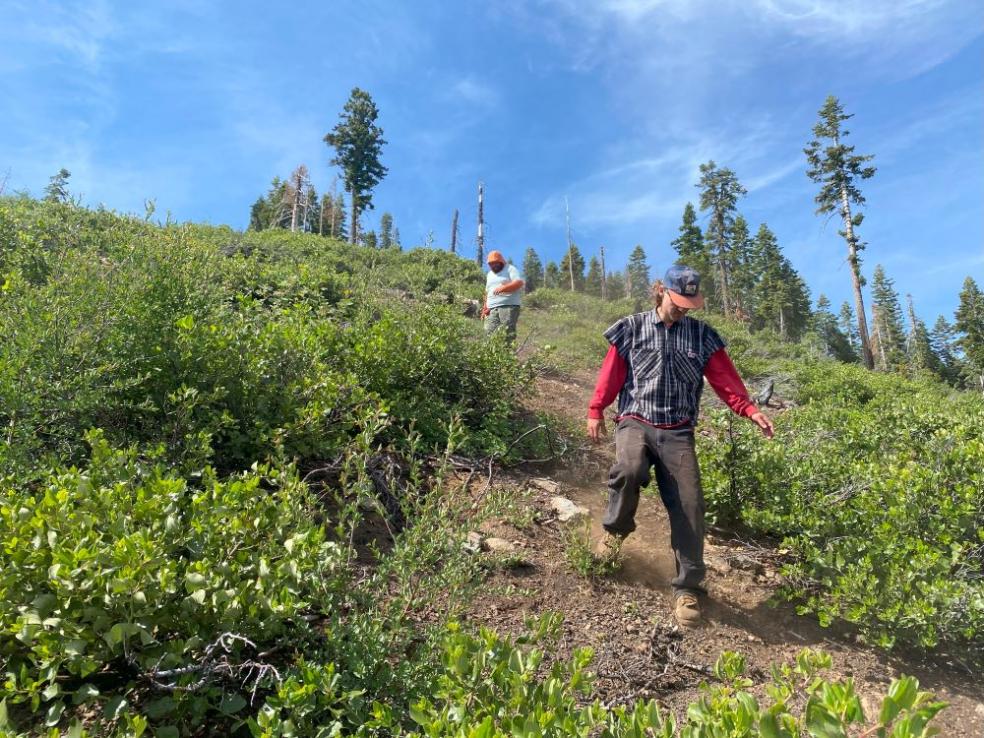
Cal Poly Humboldt Forestry Professor Jeff Kane is leading a project funded by the USDA Forest Service in collaboration with Ecologist, Kyle Merriam, to reestablish Baker Cypress in areas where it was nearly extirpated by the 2021 Dixie Fire, with significant involvement from students.
This research will be crucial in understanding the best practices for restoring fire-dependent species in a changing climate.
“The Dixie Fire reduced what was once a thriving population of millions of seedlings to mere hundreds, if not fewer,” says Kane. “Our goal is to prevent this unique species from being lost entirely in these areas.”
Baker Cypress is the northernmost species of cypress in North America and is uniquely adapted to fire. Its serotinous cones remain closed until they are exposed to the heat of a wildfire, which opens them and releases seeds, allowing a new generation of trees to take root. Historically, this mechanism has worked in the tree's favor, ensuring that fires clear out competing vegetation and create the ideal conditions for its seeds to germinate and thrive.
However, the role of fire in Baker cypress forests has been completely disrupted. In just a few decades, concern for conserving Baker cypress has abruptly shifted from too little fire to too much fire. Over a century of removing fire has led to many populations declining from dense forest conditions that result in the death of mature Baker cypress without promoting future generations. In the last couple of decades, most populations of Baker cypress have experienced at least one fire, and some have experienced two fires.
Since it can take 20 years or more for Baker cypress to produce cones to promote regeneration after fire, these areas are at risk of extirpation if another fire occurs too soon. In 2021, the Dixie Fire burned through a Baker cypress forest that had previously burned in the 2007 Moonlight Fire. This massive fire was the largest individual fire in California history burned almost a million acres and killed almost all of the immature Baker cypress at the site.
Kane's project aims to restore Baker Cypress to the Mud Lake Research Natural Area and other affected regions by collecting seeds from nearby populations and replanting them where Baker cypress has been lost.
Kane's team, which includes students from Humboldt, Chico State, and other institutions, has been collecting cones from surviving populations, extracting seeds, and germinating them in a U.S. Forest Service nursery. His team includes graduate student Olivia Moskowitz, who started this Fall and will be developing a thesis project examining the conditions that promote seedling and tree survival in burned populations of Baker cypress, or what are referred to as fire refugia. Next spring, Kane’s team will plant thousands of these seedlings in the Mud Lake area of the Plumas forest and monitor their growth over the coming years.
Student involvement is a cornerstone of this project. Six students have been deeply engaged in the restoration efforts, collecting cones, processing seeds, and planting seedlings. “This project is a unique hands-on learning opportunity for our students,” Kane says. “They’re not just learning about forest ecology in the classroom; they’re out in the field, contributing to the conservation of a rare species.”
In addition to the planting efforts, students will be involved in long-term monitoring of the seedlings, gathering data on survival rates, growth, and the conditions that contribute to successful reestablishment.
“We hope this project will serve as a model for similar restoration efforts across the state and beyond,” Kane says. “We’re not just planting trees; we’re planting the seeds of knowledge and experience that will guide future conservation efforts.”